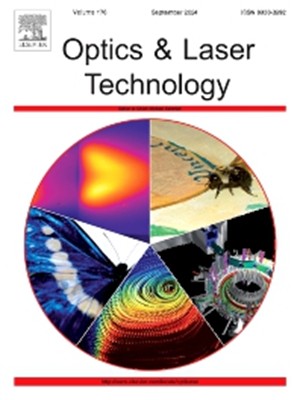Oscillating laser welding of ultra-thick titanium alloy using new flux-cored filler wire: Process stability, microstructural evolution and mechanical properties
IF 5
2区 物理与天体物理
Q1 OPTICS
引用次数: 0
Abstract
A new type of flux-cored filler wire was designed by synchronously optimizing Mo and Fe elements, and it was applied to narrow gap laser oscillating wire filler welding (NG-LOWFW) of ultra-thick titanium alloy, the effects of process parameters on the stability of welding process, microstructure and mechanical properties of welded joint were studied by experiment and numerical simulation. The results show that the oscillating laser and the liquid bridge transition mode could increase heat exchange between molten pool surface and external environment, resulting in high undercooling conditions, reduced thermal gradient, and guarantee the stability of the welding process effectively, the microstructure evolution of ultra-thick welded seam is uniform, the grain size is refined and the welding defects are restrained effectively. Moreover, Mo and Fe elements could further enhance the wetting and spreading mobility of liquid metal during welding, which contributes to the synergistic optimization of strength and toughness of ultra-thick welded joint, up to 935 MPa and 25 J. The research outcomes provide a new route for welding ultra-thick titanium alloy, which benefits further welding process and optimization.
新型药芯焊丝振荡激光焊接超厚钛合金:工艺稳定性、显微组织演变及力学性能
通过同步优化Mo和Fe元素,设计了一种新型药芯焊丝,并将其应用于超厚钛合金窄间隙激光振荡焊丝填充焊接(NG-LOWFW)中,通过实验和数值模拟研究了工艺参数对焊接过程稳定性、焊接接头显微组织和力学性能的影响。结果表明:振荡激光和液桥过渡模式能增加熔池表面与外界环境之间的热交换,产生高过冷条件,减小热梯度,有效保证焊接过程的稳定性,使超厚焊缝组织演化均匀,晶粒细化,有效抑制焊接缺陷。此外,Mo和Fe元素可以进一步增强焊接过程中液态金属的润湿和扩散迁移率,有助于超厚焊接接头的强度和韧性协同优化,最大可达935 MPa和25 J.研究结果为超厚钛合金的焊接提供了新的途径,有利于进一步的焊接工艺和优化。
本文章由计算机程序翻译,如有差异,请以英文原文为准。
求助全文
约1分钟内获得全文
求助全文
来源期刊
CiteScore
8.50
自引率
10.00%
发文量
1060
审稿时长
3.4 months
期刊介绍:
Optics & Laser Technology aims to provide a vehicle for the publication of a broad range of high quality research and review papers in those fields of scientific and engineering research appertaining to the development and application of the technology of optics and lasers. Papers describing original work in these areas are submitted to rigorous refereeing prior to acceptance for publication.
The scope of Optics & Laser Technology encompasses, but is not restricted to, the following areas:
•development in all types of lasers
•developments in optoelectronic devices and photonics
•developments in new photonics and optical concepts
•developments in conventional optics, optical instruments and components
•techniques of optical metrology, including interferometry and optical fibre sensors
•LIDAR and other non-contact optical measurement techniques, including optical methods in heat and fluid flow
•applications of lasers to materials processing, optical NDT display (including holography) and optical communication
•research and development in the field of laser safety including studies of hazards resulting from the applications of lasers (laser safety, hazards of laser fume)
•developments in optical computing and optical information processing
•developments in new optical materials
•developments in new optical characterization methods and techniques
•developments in quantum optics
•developments in light assisted micro and nanofabrication methods and techniques
•developments in nanophotonics and biophotonics
•developments in imaging processing and systems

 求助内容:
求助内容: 应助结果提醒方式:
应助结果提醒方式:


